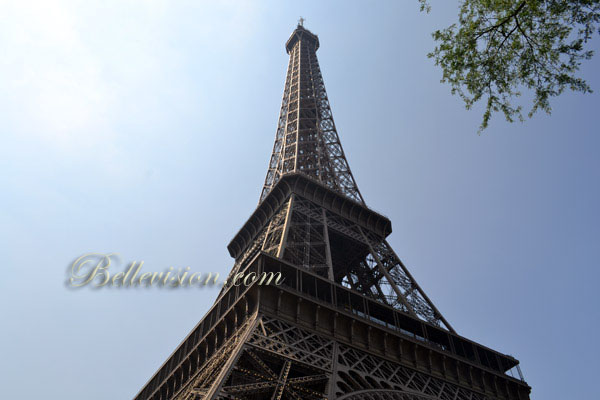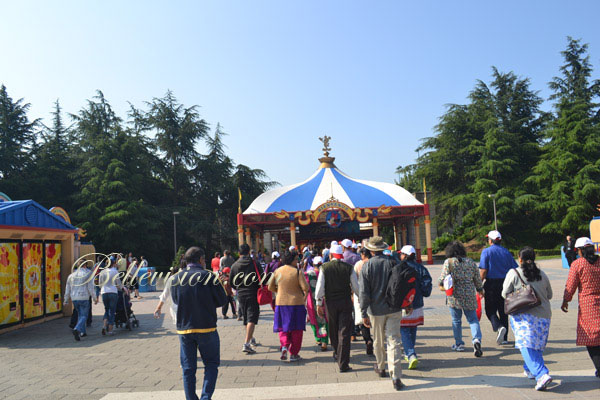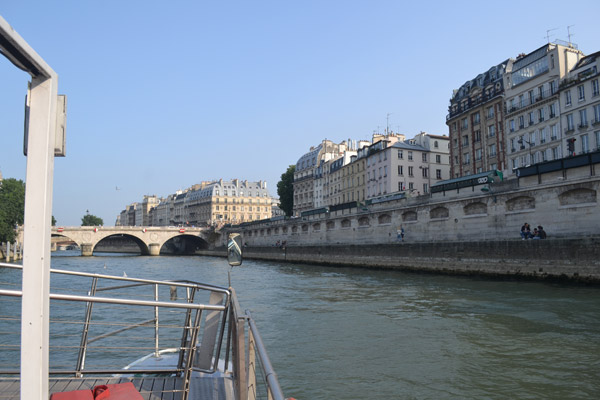Memorable Tour Through Historic Paris and Enchanting Disneyland
By Dr. Eugene DSouza, Moodubelle
Bellevision Media Network
Udupi, 11 Aug 2013: On the third day of our ‘Wonders of Europe’ tour, we had early wakeup call at 3 am. By 4 am we were ready with our luggage outside the hotel and waited to the coach to drive us to St. Pancreas Railway station to take the high-speed ‘Eurostar’ train to Paris.
By 5.30 am we were at the station and went through all the security and immigration formalities as if we were travelling by air. As we had separate visa for UK and multiple entry visa to other European countries known as Schengen countries, our passports and visas were checked by the European Union Immigration officials and were allowed to enter the waiting hall with comfortable seating arrangements where we had our packed breakfast and waited patiently for the boarding call twenty minutes prior to the departure of the Eurostar scheduled at 7.01 am.
As the boarding call was given we dragged our luggage and entered the compartments of the Eurostar allotted to our group. The train started right in time and gradually picked up speed. After moving on open ground for sometime during which we could view the rural landscape of southern UK, the train entered the Channel Tunnel with darkness all-round and lights within the compartments.
Eurostar is a high-speed railway service connecting London with Paris and Brussels. All these trains pass through the Channel Tunnel between the United Kingdom and France, owned and operated separately by Eurotunnel.
In London, Eurostar trains originates from St Pancras station and terminate in Paris at Gare du Nord station. The service is operated by eighteen-coach Class 373/1 trains which run at up to 300 kilometers per hour (186 mph) on a network of high-speed lines. In the United Kingdom the two-stage Channel Tunnel Rail Link project was completed on 14 November 2007 and renamed High Speed 1, when the London terminus of Eurostar transferred from Waterloo to St Pancras.
The history of Eurostar can be traced to the 1986 when it was planned to construct a rail tunnel to provide a cross-channel link between Britain and France. In 1988 construction began and Eurotunnel was created to manage and own the tunnel, which was finished in 1993 and the official opening took place in May 1994.
On 23 September 2003 passenger services began running on the first completed section of High Speed 1. The Channel Tunnel used by Eurostar services holds the record for having the longest undersea section anywhere in the world, as well as being the second longest rail tunnel in the world.
When the train emerged once again into open space we were on the French soil. As the train hurtled towards Paris we could view the vast French landscape covered with greenery with agricultural crops such as barley, wheat and potatoes. After a journey of around two and half hours we reached Gare du Nord railway station in Paris where Alessandro from Italy, the coach captain of the Long Distance Coach (LDC) from Rome was waiting for us.
Our Tour Manager, Kunal Gorekar introduced us to Alessandro and said that henceforth we would be travelling by this LDC till Rome, our last destination. After the luggage being loaded into the coach we headed towards the city of Paris. As we entered the suburb of the city, the buildings seemed to be familiar somewhat like those seen in England. Throughout Europe this was the experience as the Gothic, Baroque and Renaissance architectural designs had their influence over the construction of many of the buildings, public as well as private throughout the European continent.
.jpg)
.jpg)
.jpg)
.jpg)
.jpg)

Coach Captain Alessandro and Tour Manager Kunal Gorekar
.jpg)
.jpg)
.jpg)
.jpg)
.jpg)
.jpg)
.jpg)
.jpg)
.jpg)
.jpg)
.jpg)
.jpg)
.jpg)
Seine River
.jpg)
Notre Dame Cathedral
.jpg)
.jpg)
Inavalides-Mausoleum of Napoleon Bonaparte
.jpg)
.jpg)
National Assembly Building
The first historical monument that drew my attention was the so called the July Column which is a monumental column in Paris commemorating the Revolution of 1830. It stands in the center of the Place de la Bastille and celebrates the three glorious days of 27, 28 and 29 July 1830 that led to the overthrow of King Charles X of France and the beginning of the "July Monarchy" of King Philippe. The July Column was built between 1835 and 1840 and was engraved in gold with the names of Parisians who died during the revolution. Over the Corinthian capital is a 16 feet wide gallery surmounted with a gilded globe, on which stands a colossal gilded figure known as the "Spirit of Freedom".
As we moved to the center of Paris we could see a number of monuments and buildings associated with the history of Paris in particular and that of France in general. The Notre Dame Cathedral, the National Assembly and a host of other important landmarks of Paris could be viewed on the way to the Avenue des Champs-Elysees considered to be the most famous street in Paris with several historical monuments, cinemas, cafes, luxury specialty shops and horse chestnut trees. As the French National Day was three days away on 14 July, seating arrangements were being made on both sides of the street for the public to view the National Day parade.
At the eastern end of the Champs-Elysees is the largest public square in Paris known as Place de la Concorde. The square surrounding the statue was created in 1772, by architect Jacques-Ange Gabriel. It was known as the ‘Place Louis XV’. In 1792, during the French Revolution, the statue was replaced by another large statue, called ’Liberté’ (freedom) and the square was called ‘Place de la Révolution’. A guillotine was installed at the center of the square and in a time span of only a couple of years, 1119 people were beheaded. The then reigning king Louis XVI, the queen Marie-Antionette and Robespierre one of the revolutionary leaders were also guillotined at the same place. After the revolution the square was renamed several times until 1830, when it was given the current name ’Place de la Concorde’.
In the 19th century the 3200 years old obelisk from the temple of Ramses II at Thebes was installed at the center of the Place de la Concorde. It is a 23 meters (75 ft) tall monolith in pink granite and weighs approximately 230 tons. In 1831, it was offered by the Viceroy of Egypt to Louis Philippe. Three obelisks were offered by the Viceroy, but only one was transported to Paris.
The obelisk - sometimes dubbed ’L’aiguille de Cléopâtre’ or ‘Cleopatra’s Needle’ is covered with hieroglyphs picturing the reign of pharaohs Ramses II and Ramses III.
After moving around the Place de la Concorde, we proceeded towards the western end of Avenue des Champs-Elysees where we came across one of the most famous landmarks of Paris, the ‘Arc de Triomphe’ (Napoleon’s Triumphal Arch). The arch was commissioned by Napoleon in 1806 to commemorate his victories, but he was defeated and ousted before the arch was completed. However, the arch was completed during the reign of Louis Philippe in 1836. The Arc de Triomphe is engraved with names of generals who commanded French troops during Napoleon’s regime. When Napoleon’s body was brought back to France from Saint Helena on 15 December 1840 it was taken through the arch on its way to the final resting place at the Invalides.
The design of the arch by Jean Chalgrin is based on the Arch of Titus in Rome. The triumphal arch is adorned with many reliefs, most of them commemorating Napoleon’s battles. The best known relief is the Departure of the Volunteers in 1792, also known as the Marseillaise. At the top of the arch are 30 shields, each of them bears the name of one of Napoleon’s successful battles. Below the arch is the Grave of the Unknown Soldiers, honoring the many who died during the First World War.

Place de la Concorde
.jpg)
’Cleopatra’s Needle’
.jpg)
.jpg)
.jpg)
.jpg)
The Arc de Triomphe
.jpg)
La Marseillaise as represented on the Arc de Triomphe
.jpg)
Sculpture in Arc de Triomphe
.jpg)
La Résistance de 1814
.jpg)
.jpg)
Passing by the side of the Napoleon’s Triumphal Arch we headed towards Europe’s best known landmark and the most famous symbol of Paris-the Eiffel Tower. The top of the Eiffel Tower could be seen from different parts of Paris.
After our bus was parked in the designated parking place, we walked towards the tower and stood at the end of the queue of tourists who were waiting for their turn to be taken by a giant elevator at the base to the first and second stage of the tower.
Our turn to enter the elevator came after about one hour’s wait. The huge lift that can hold around 75 persons moved up to the first and second level of the tower. We alighted at the second level and went around the platform from where a large part of Paris could be viewed. I managed to take a number pictures of the panoramic view of Paris below. The walk from ground level to the first level is over 300 steps, as is the walk from the first to the second level. Although there are stairs to the third and highest level, these are usually closed to the public and it is usually accessible only by lift.
As our ticket included the lift ride till the third level, that is, the top of the tower, once again we lined up for another smaller lift which took us to the top. As the lift was moving upwards we could see the entire city of Paris in its profile. We had the stunning view of the River Seine and numerous bridges across, historical monuments and other buildings in classical mould and even modern structures co-existing in a pleasant manner. The 360 degree view of the city was just amazing and the experience was exhilarating.
The Eiffel Tower named after the engineer Gustave Eiffel, whose company designed and built the tower. It was erected in 1889 exactly a century after the beginning of the French Revolution (1789) as the entrance arch to the 1889 World’s Fair. Gradually, the Eiffel Tower became both a global cultural icon of France and one of the most recognizable structures in the world. The tower stands 324 metres (1,063 ft) tall, about the same height as an 81-storey building. The structure took more than two years to complete. Each one of the about 12,000 iron pieces was designed separately to give them exactly the shape needed. All pieces were prefabricated and fit together using approx. 7 million nails.
After spending considerable time at the top of the tower, once again we lined up to get to the second level by the smaller lift and to get the larger elevator to descend to the base of the Eiffel Tower.

.jpg)
.jpg)
.jpg)
.jpg)
.jpg)
.jpg)
.jpg)
.jpg)
.jpg)
.jpg)
.jpg)
.jpg)
.jpg)
.jpg)
.jpg)
.jpg)
.jpg)
.jpg)
Having completed the site seeing for the day we got into the bus and headed towards the hotel.
The second day in Paris was set aside for a visit to the Disneyland located 32 kilometers from the city of Paris. After nearly an hour-long bus-ride we reached the Disneyland. We waited for sometime as our Tour Manager-Kunal completed the formalities of endorsing the tickets.
After walking for about fifteen minutes, we entered the main gate and found ourselves in the wonder world of fantasy and imagination-the world of cartoon and fairy tales characters.
The entire Disneyland complex is like a township with streets and lanes, restaurants and shops and structures designed to suit the themes.
Disneyland Paris was inaugurated on 12 April 1992 as an entertainment resort. It covers 4,800 acres (19 km2) and encompasses two theme parks, several resort hotels, a shopping, dining, and entertainment complex, and a golf course, in addition to several additional recreational and entertainment venues. A second theme park, Walt Disney Studios Park opened in 2002. The resort was designed specifically to follow the model established by Walt Disney World in Florida. Paris Disneyland is divided into four themed sections-Discoveryland, Frontierland, Adventureland and Fantasyland.
In a day’s time it was not possible to view all the themed sections, neither to take adventurous rides. As our group split into smaller groups and headed towards the sections of their interest, few of us headed towards section known as “It’s A Small World”. It is a stereotypical cute Disney ride. Designed mostly for small children, this is a perfect ride for those who can enjoy the most impressive presentation by the dolls representing small children from different cultures and countries.
We tried to catch up with the ‘flying elephant ride’ after waiting in the line for about an hour. Similar queues greeted all those who wished to have other types of adventurous rides as well. We visited Mickey Mouse hall and had pictures taken in his company, visited the castle and viewed the exhibits connected with various fairy tales and witnessed the Disney Parade which usually takes place at regular intervals on the main street of the Disneyland with famous cartoon characters such as Mickey Mouse, Donald Duck and others riding the fancy trolley accompanied by loud music and followed by hordes of tourists. A large number of outlets were seen selling verities of souvenirs made of different materials. Tourists can also have a quick ride through the entire Disneyland through a mini-train.

.jpg)
.jpg)
.jpg)
.jpg)
.jpg)
.jpg)
.jpg)
.jpg)
.jpg)
.jpg)
.jpg)
.jpg)
.jpg)
.jpg)
.jpg)
.jpg)
.jpg)
.jpg)
.jpg)
.jpg)
.jpg)
.jpg)
.jpg)
.jpg)
.jpg)
.jpg)
.jpg)
.jpg)
.jpg)
.jpg)
.jpg)
.jpg)
.jpg)
.jpg)
I was quite disappointed that I could not see some of the theme sections and could not experience additional rides due to paucity of time and daunting queues. However, at the end of the day, I had the satisfaction of experiencing at least some sections of the Disneyland.
Having gathered at the predetermined meeting spot we walked back to the bus and headed towards the city for our last engagement in Paris-the Seine River Cruise.
We took the cruise at a spot on the bank of River Seine near the Eiffel Tower. The one hour long cruise moving at a moderate speed gave us an opportunity to view many of the historical monuments by the side of the river including the famous Notre Dame Cathedral that was built in the 14th century in the Gothic style of architecture. Other monuments included the National Assembly, the City Hall, the Louvre Museum and host of ornate bridges and classical buildings and structures. On both sides of the river tourists and local people of Paris could be seen enjoying the evening with leisure and waving towards the cruisers.
As we approached a bridge, i could see thousands of padlocks attached to both sides of the railings. This bridge is known as ’Love Lock Bridge’. It is said that a couple writes their names on a padlock and locks it onto one of the bridges. They then throw the key into the Seine River as a symbol of their undying love. Some say the only way to break the seal of love brought on by this love lock act is to find the key and unlock the padlock. Of course, that is nearly impossible, since the keys lie at the bottom of the river.

.jpg)
.jpg)
.jpg)
.jpg)
.jpg)
.jpg)
.jpg)
.jpg)
.jpg)

.jpg)

.jpg)
.jpg)
’Love-lock Bridge’
.jpg)
After spending two days in Paris and having had the wonderful experience of viewing the historical monuments, technological marvel in the Eiffel Tower, visiting enchanting Disneyland and undertaking the enjoyable boat tour in the River Seine we waited for the next morning to proceed to another country-Belgium and its capital-Brussels.
Also Read
Part 1 : ’Wonders of Europe’ - London in a Day




 Write Comment
Write Comment E-Mail To a Friend
E-Mail To a Friend Facebook
Facebook Twitter
Twitter  Print
Print 















Once again BV team publishing wonders of Europe travelogue. Beautiful picture and very imaginably narrated the days in France. Well done bravo Dr. Eugene sir. write more thanks to BV team, Jonam .